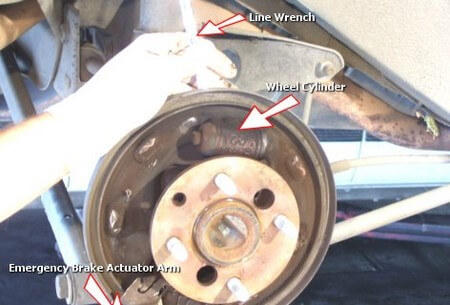Below guide will teach you How to Replace a Wheel Cylinder . Please follow the instructions carefully.
Things You’ll Need:
- Screwdriver
- Combination Wrench Set
- Brake Bleeder Kit
- Mallet Hammer
- Socket and Ratchet Set
- Jack Stand Set
- 3/8 in. Drive Ratchet
- Wheel Cylinder
Estimated Costs:
- DIY Costs: Est. $160.41 parts only
- Shop Costs: Est. $317.38 parts and labor

Image may not be specific to your car.
Instructions:
- Park the vehicle on a flat surface.
- Loosen the lug nuts before lifting the vehicle up on jack.
- Using the floor jack, raise the vehicle.
- Prop the vehicle up on jack stands to ensure your safety.
- Take all the lug nuts away and detach the wheels from the vehicle.
- Take the brake drum out and also star wheel adjuster if required.
- Take a spray bottle filled with a mixture of water and detergent, wipe off any debris of dirt from the surface of the brake assembly. Never use compressed air to clean the brake assembly. Examine properly the brake shoes for any damage.
- Take the primary and secondary brake shoe return springs from the anchor pin and brake shoes away.
- Also disconnect the adjuster cable and spring assembly. Take the star adjusting screw away and thread the adjuster in entirely.
- Disconnect the front brake shoe retainer and also take away the front brake shoe and parking brake link.
- Next, take the parking brake lever out from the rear brake shoe. Take the rear brake retainer and rear brake shoe away as well.
- Now, first remove the brake line from the wheel cylinder by unfastening the bolts and then remove the wheel cylinder from the backing plate by unfastening the retaining bolts.
- Secure the new wheel cylinder to the backing plate with bolts and also reassemble the brake line to the new wheel cylinder.
- Take lithium grease and apply it on the backing plate contact points.
- Reassemble the brake shoes by reversing the entire process. Make certain that brake shoes won’t receive any debris or dirt during installation.
- Repeat the steps from 6 to 15 for the other side.
- On the passenger side rear brake, locate the brake bleeder valve.
- Take a piece of clear plastic tubing and fix it on the brake bleeder screw and insert the other end of the tubing into the container filled with brake fluid.
- Instruct your assistant to depress and hold the brake pedal.
- Loosen the bleeder screw to let the brake oil evacuate from it.
- Fasten the screw and repeat the steps from 17-21 till no air bubbles pop out of the tubing.
- Do the same on the right side of the rear.
- Fix the wheels back to the vehicles and test the working of the new wheel cylinders by taking a small drive.


